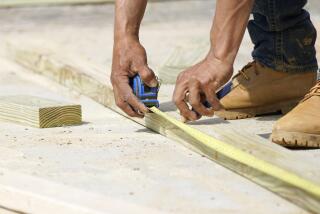Home Improvement : Planning Is the Secret to Remodeling Success
- Share via
QUESTION: I have decided to do some major remodeling in my home that will require a professional. I need help. I don’t know where to begin.
ANSWER: Our advice can be summed up in three words--plan, plan, plan.
The real key to most successful remodeling projects is thorough planning. The first step is to clearly define your ideas by preparing a well-detailed needs list. You should attempt to be as specific as possible with respect to the materials, finishes and products to be used.
The next step is to agree on a realistic budget based upon the work you wish to have performed.
Once you have established needs and budget, then some design expertise by an architect, designer or contractor/designer is in order. Many general contractors have in-house design services.
The completed design should then be bid to at least three reputable general contractors. Make sure that these contractors are licensed and have all the proper insurances required to perform such work. Remember the cheapest price may not give you the best value.
A real professional will be anxious for you to visit previous jobs to see his work and talk to his customers.
Additionally, you should contact the Contractors State License Board and the Better Business Bureau to ensure that there are no complaints against that contractor. Also, both of these organizations offer very helpful and highly informative pamphlets free of charge.
When it comes to the contract, make sure that everything is in writing, leave nothing to chance. If it’s not in writing, chances are that you won’t get it, at least not without paying more for it.
Before to making the final payment, make sure that the contractor provides you with releases of lien for all labor and material and provided for the job. An ounce of planning is truly worth a pound of cure.
Cracks in Stucco Wall Keep Coming Back
Q: I have cracks in my stucco that have been patched, but they keep coming back. The filler the painter used is crumbling. The painter said there isn’t anything he can do. How can I make permanent patch?
A: It may either be that your painter is not versed in stucco patchwork, or that you have substantial ground movement under your house. Try a paintable silicone caulk. Scrape the old patch material out of the cracks, make sure that the inside surfaces are free of paint and loose debris, and force the new caulk deep into the crack joint.
How to Strip Old Layers of Wallpaper
Q: We have just purchased a previously owned home, and one of my first projects is to remove all of the horrible wallpaper. It’s so busy it gives me a headache. Can you offer some tips?
A: Besides patterns that you are not happy with, wallpaper in poor condition, multiple layers of wallpaper and flocked wallpaper must be removed before you can hang a new covering. If the existing material is strippable, it will come off easily when you pull at a corner or seam.
Before removing non-strippable wallpaper, break the surface of the covering by sanding it with very coarse sandpaper. You can also score the wall with a saw by scraping the saw’s entire cutting blade against the covering in many places and in various directions.
To remove the paper you can use either a steamer (can be rented from your local paint or wallpaper store) or a garden sprayer.
In both cases, the active ingredient is water, but there are concentrated solutions available that will hasten the process by helping to break down the old glue.
A steamer converts water to steam that runs through a hose to a device that you move along the wall. This allows the steam to penetrate the covering. To use a garden sprayer, fill it with very hot water and spray the water onto the wallpaper. You will be able to begin removing the paper in a matter of minutes by using a broad knife and working from the top down.
If several layers of paper exist, it’s a good idea to remove each layer separately. Extreme caution should be employed so as not to damage the drywall below. This may be virtually impossible if the wallpaper was originally applied to a raw, unprepared surface. In this case, you will need to repair the wall with a spackling paste or drywall compound.
After all the repairs have been made and the surface has been thoroughly sanded, apply a coat of flat, oil-based enamel undercoat or primer seal. You are now ready to install your new wallpaper.
Morris D. Carey and James O. Carey are syndicated columnists and general contractors in the San Francisco Bay area. Address questions to the Carey brothers at 510 Garcia Ave. No. E, Pittsburg, Calif. 94545.
NEW COLUMN “On the House,” a new home improvement and repair column, begins today. The column, written by brothers Morris D. and James O. Carey, licensed general contractors in the San Francisco Bay area as well as syndicated columnists, will answer readers’ questions on all aspects of home improvement.
More to Read
Inside the business of entertainment
The Wide Shot brings you news, analysis and insights on everything from streaming wars to production — and what it all means for the future.
You may occasionally receive promotional content from the Los Angeles Times.










